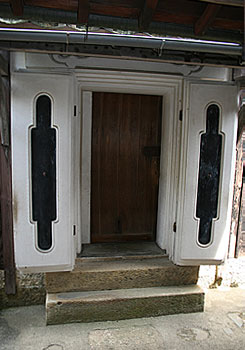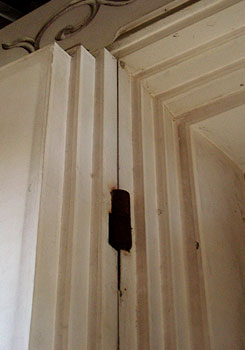|
||
 |
||
2@The heavy fireproof swing doors used in fireproof storehouses *dozou y . The doors had a timber framework to which first mud walls *tsuchikabe yΗ, and then white or black plaster coat *shikkui ½ς, were applied as in fireproof storehouse construction *dozou-zukuri y ’ (see *tsuchido yΛ). The finished door within its fireproof plaster coat was about 18cm thick. The peripheral doorframe, likewise cased in plaster, had a timber skeleton which resembled a lintel gate *kabukimon ₯Ψε, with uprights kabukibashira ₯Ψ and a lintel projecting at both ends *kabuki ₯Ψ. It stood in front of the main frame of the building, to which it was fastened back by long iron straps attached to the hinges. The most striking feature of the doors was the stepped profile *jabara Φ of their flanged reveals, which were designed to interlock precisely both with an identical profile on the frame and with the opposing door, reducing the possibility of flames spreading to the interior of the storehouse through gaps around the doors (for even greater security, these gaps were sealed with mud). The resemblance of the stepped profile of the reveals to the double folded door leaves of the original kannonbiraki tobira (See 1), when the doors stand open, probably accounts for the use of the term in this case.
 @
@
uchigura ΰ FNagatomi ix house (Hyougo)
@
(C)2001 Japanese Architecture and Art Net Users System.@No reproduction or republication without written permission.
fΪΜeLXgEΚ^ECXgΘΗASΔΜRecΜ³f‘»E]ΪπΦΆά·B

